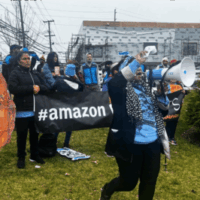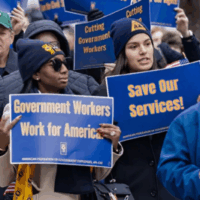Government agencies, and their enforcement of safety regulations, play a crucial role in protecting workers in dangerous workplaces. There is a real cost to curtailing enforcement and stripping away protections—a cost that is borne out in more workers being killed on the job and more getting sick and injured. Yet despite the strong empirical evidence about their effectiveness, the Trump administration and Congressional Republicans have acted in great haste to repeal these protections, thereby endangering workers.
Though worker safety has improved over the past decade, more than 4,800 workers are killed on the job every year. Millions more suffer serious work-related injuries. In a new report, NELP found that an average of 27 workers a day suffered severe injuries—amputations and other injuries requiring hospitalization—in the 29 states that report to federal government on workplace safety.
Recent Progress on Worker Safety in Jeopardy
There are two government enforcement agencies whose sole job is to help ensure that dangerous industries provide safe working conditions: the Occupational Safety and Health Administration (OSHA), and the Mine Safety and Health Administration (MSHA). Both of these agencies were every effective over the last eight years in reducing deaths and injuries on the job. In fact, the nation’s mines are now at a record low for miners killed on the job. The rate of workers being killed on the job in all industries has also dropped: from 3.7 per 100,000 workers in 2008 to 3.4 per 100,000 in 2015 (data not yet available for 2016). These statistics are no fluke; they are a result of enhanced enforcement, strategic targeting of enforcement resources, new safety and health regulations, and increased outreach and engagement.
Comparing the record of the average number of workplace fatalities over the last three years of the Obama administration (2013-2015) to the last three years of the Bush administration (2006-2008), there was an average of almost 1,000 fewer workers killed on the job each year under the Obama administration. Specifically, an average of 4,747 workers were killed on the job each year from 2013-2015 versus an average of 5,570 deaths per year from 2006-2008.
And this success is despite the fact that OSHA has very limited resources: it would take the agency 145 years to investigate every workplace under its jurisdiction just once. OSHA also had a much more robust enforcement program under the last administration, when it issued nearly 1,200 enforcement actions involving significant penalties between 2009-2015. During a comparable period in the Bush administration (2002-2008), the Bush administration issued only 783 cases—even though there were more workplace fatalities and injuries during that period.
Over the last eight years, OSHA has also worked hard to increase the effectiveness of its whistleblower program after years of inattention and underfunding during the Bush administration. Under the last three years of the Obama administration, the number of cases that saw a positive outcome for workers who suffered retaliation for exercising their rights was double that of a comparable period during the Bush administration, and the amount of money restored to workers almost tripled during that time span (from $38 million awarded from 2006-2008, versus $108 million awarded from 2012-2015).
Safety Pays: Enforcement Prevents Injuries and Saves Employers Money
A substantial body of empirical evidence underscores the effectiveness of strong government enforcement in reducing injuries. Recent studies by the Rand Corporation and by the business schools of Harvard University and the University of California, Berkeley confirm that OSHA inspections result in substantially and persistently reduced rates of both injuries and insurance costs, to the tune of billions of dollars annually for employers both large and small.
Evaluation of OSHA’s standards have yielded similar conclusions: OSHA’s rule to prevent workers getting killed in trenching and excavation work has reduced workplace deaths by more than 40 percent; its standard for handling blood-borne pathogens has virtually eliminated occupationally acquired hepatitis B fatalities that used to kill 120 workers every year; and its grain-handling standard led to a 70 percent decrease in fatalities from explosions. In fact, since the Occupational Safety and Health Act and the Mine Safety and Health Act were enacted in the 1970s, the rate of workers being killed on the job has declined by more than 75 percent, and the number of fatalities has declined from about 14,000 a year in 1970 to 4,836 worker deaths in 2015, with a workforce twice as large.
Stripping Away Worker Protections in the First 100 Days
In just the first 100 days, the Trump administration and Republicans in Congress have already made it easier for companies to steal workers’ wages and cut comers on safety (they repealed the regulations on Fair Pay and Safe Workplaces). They also made it easier for companies that maim and injure workers to hide these injuries (they repealed the OSHA regulations clarifying 45-year-old recordkeeping obligations).
President Trump has also proposed drastic budget cuts in the Department of Labor, where the safety agencies are housed. Draconian cuts in OSHA—for whom it would already take around 145 years to inspect every workplace under its jurisdiction just once—would cripple the agency. Adding insult to injury, the President signed a new executive order stating that for every new worker protection, two existing workers safeguards must be removed. This is dangerous—a gut punch to all workers.
Further, the Department of Labor has all but stopped communicating with the public on larger enforcement actions—a departure from the last 16 years. Press releases—and there were a few hundred each year—were issued by the Department to let other employers and workers know what the agency was finding. The releases highlighted the violations that were found and made it clear there were consequences to violating the law. But if there are virtually no press releases being issued now, that is a signal to employers that it’s okay to cut corners and forget about safety.
The Cost of Repealing Protections
There is a cost when worker protections are cut. When Congress and the Bush administration overturned OSHA’s ergonomics rule in 2001, the result was that more than 300,000 workers a year continued to suffer from serious and preventable work-related musculoskeletal disorders.
When the Trump administration recently postponed the enforcement date for the new OSHA rule to protect workers from silica dust exposure, which causes a debilitating and incurable lung disease as well as cancer, it meant that 160 workers would lose their lives.
And despite finding that workers exposed to the beryllium at current allowable limits are at increased risk of developing chronic beryllium disease and lung cancer, the Trump administration has delayed the effective date of these new protections as well. It appears they are moving to completely weaken the new regulation.
This new administration is clearly not committed to holding businesses accountable when they cut corners and endanger our nation’s workers. It is clear that any new cutbacks in enforcement positions or targeted strategies will result in more on-the-job deaths and injuries, and more families torn apart by the loss of a loved one and a breadwinner.
On this Worker Memorial Day, we call on the Trump administration and Congress to honor all the people who have tragically lost their lives on the job and to recommit to enforcing our nation’s worker safety laws. No worker should have to sacrifice his or her life for a paycheck.
Debbie Berkowitz is senior fellow for worker safety and health with the National Employment Law Project, and previously served as chief of staff and senior advisor with the Occupational Safety and Health Administration.
This post originally appeared in The Huffington Post.




